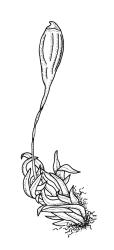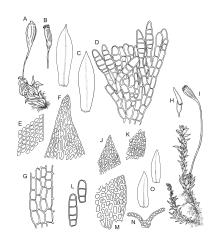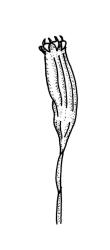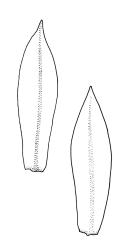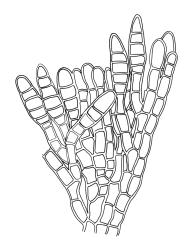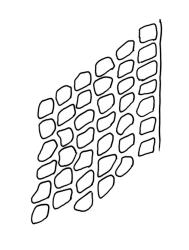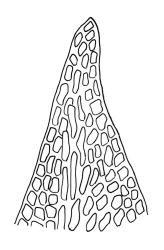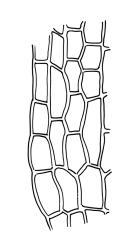- ≡ Codonoblepharon minutum (Müll.Hal. & Hampe) Matcham & O'Shea, J. Bryol. 27: 132 (2005) – as minutus
- = Zygodon mucronatus Broth. in Beckett, Trans. & Proc. New Zealand Inst. 29: 441 (1897)
Plants dimorphic, forming dense tufts on bark or rock, yellow-green to olive-green above, red-brown below, weakly lustrous; ♀ plants mostly c. 3 mm tall, usually unbranched; male plants smaller, mostly c. 1(–2.5) mm, often branched by innovation and bearing >1 perigonia. Stems simple or branched, in cross section with all cells uniformly thin-walled or with c. 1 layer of thickened cortical cells, central strand lacking; rhizoids present on lower stems, brown, finely papillose. Leaves erect and weakly spiralled around the stem when dry, spreading when moist, oblong- or elliptic-lanceolate, apiculate, entire, at base not decurrent, 0.5–1.5 × 0.20–0.35 mm; margins plane or rarely slightly reflexed in lower half; upper laminal cells rhombic to ± quadrate, moderately thick-walled, smooth, usually in oblique rows, c. 8–12 × 6–9 μm; basal cells rectangular, thinner-walled, to c. 27–42 × 12–15 μm, smooth. Costa stout and little tapered, mostly short excurrent and filling the apiculus, rarely percurrent or subpercurrent, c. 42–60 μm wide near the base, yellow- or red-brown. Gemmae borne in clusters on axillary stalks, usually numerous, clavate with 4–7 transverse walls, (50–)90–150 μm. Laminal KOH colour reaction positive yellow.
Dioicous. Perichaetia terminal, with leaves larger than vegetative but otherwise similar. Perigonia gemmiform, c. 0.5 mm, terminal or appearing lateral because of innovation, with 8–10 antheridia and few or no paraphyses; perigonial bracts very small, broadly ovate, apiculate, the innermost with large, thin-walled cells and costa ending below the apex. Setae 1.5–3 mm, dextrorse above, often sinistrorse below, smooth; capsules exserted, narrowly obovoid from a rather short neck, becoming cylindric with age, deeply 8-furrowed when dry, light brown at maturity, 1–1.5 mm; exothecial cells rectangular, in distinct thick- and thin-walled bands; stomata superficial, restricted to neck; annulus not seen; operculum conic, with a short, thick, slightly curved beak. Peristome double; no preperistome observed; exostome of 8 pairs of teeth, hyaline to pale brown, reflexed when dry, vertically point striated above, horizontally below; endostome segments 8, sometimes with 8 rudimentary segments in between, to ⅔ the height of the exostome, hyaline, smooth or scabrous on the outer surface, finely papillose or striate papillose on the inner surface. Calyptra cucullate, smooth, fugacious. Spores globose, finely papillose, 15–18(–20) µm.
The colouration and lustre of the plants, and the weakly obliquely arranged laminal cells are suggestive of small plants of Z. menziesii. The present species could also be confused with Z. gracillimus but can be differentiated from that species by its excurrent costae, generally larger leaves, and the much thinner-walled cells of the stem. The decidedly dimorphic nature of the sexual plants in Z. minutus also facilitates separation.
NI: N Auckland, including offshore islands (PK, HC, Waiheke I.), S Auckland (Whatawhata Te Pohū Reserve in Raglan County), Gisborne (Panikau, Makaretu, Cape Runaway), Hawke’s Bay (Wairoa – several collections, near Waipukurau), Wellington (Whanganui and environs, Wairarapa Lake Shore Scenic Reserve); SI: Marlborough (Kaikōura), Canterbury (Napenape, Banks Peninsula), Otago (Aramoana, Otago Peninsula, Akatore Stream), Southland (near Riverton); St; Ch. Lewinsky (1990) recorded this species from Pine Hill in Dunedin on the basis of an early W. Bell collection.
Australasian. Lewinsky (1990) recorded it from mainland Australia (south-east South Australia and coastal Victoria) and Tasmania (including Flinders I.), as well as one locality each in south-west Western Australia and south-east Queensland.
Zygodon minutus is predominantly coastal in distribution and tolerant of some salt spray. This species is widespread in N Auckland L.D., and occurs at several localities on the east coast of the North I. Recorded from the west coast of the North I. only from the vicinity of Whanganui (Wellington L.D.) There is a single collection from the shore of Lake Wairarapa (Wellington L.D.). The few scattered collections from South I. are restricted to the eastern and southern coasts (see Lewinsky 1990, fig. 99). It ranges from near sea level (Warkworth, N Auckland L.D.) to at least 80 m (Waipoua River, N Auckland L.D.) on the North I. and to c. 160 m (near Riverton) on the South I.
Zygodon minutus is usually epiphytic and has been reported from both living and dead trees, often growing in bark fissures. Host species include the indigenous Avicennia marina, Coprosma propinqua, Corynocarpus laevigatus, Piper excelsum, Melicytus ramiflorus, Myoporum laetum, Vitex lucens, and Podocarpus totara, as well as the introduced genera Populus, Salix, and Sambucus. It also occurs as an epilith on dry, shaded limestone (as at Waro Limestone Scenic Reserve, N Auckland L.D.), concrete and volcanic rock (as at Motukōrea I., N Auckland L.D.). Frequently associated mosses include Calyptopogon mnioides, Syntrichia papillosa, Tortula abruptinervis, and T. muralis.



